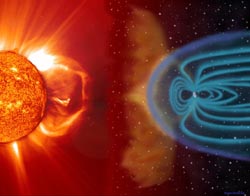During the 1960s solar physicists realized that the Sun throbs constantly as pressure waves — literally sounds — echo and resonate throughout the solar interior. There are millions of different resonances inside the Sun, the "loudest" of which cluster around one dominant frequency of 0.003 hertz, that is, one vibration every 5 minutes. These in-and-out motions cause the photosphere to heave out and in by tens of miles, a rhythmic cadence that propagates (via the solar wind) out into interplanetary space.

Sun: ESA / NASA / SOHO; Magnetosphere: NASA
What's interesting, and only now coming to light, is how pervasively the Sun's vibrations make their presence known on Earth. When five researchers, led by statistician David Thomson (Queen's University, Ontario), started looking into the cause of some recent satellite failures, they turned up vibrations matching the Sun's in a host of settings they hadn't expected: the magnetosphere, ionosphere, cellular-phone systems, transoceanic cables, and even Earth itself.
The last of these seems the most remarkable. About a decade ago geophysicists realized that faint resonant "hums" are constantly present in seismic records. There's no consensus on what might be causing them, though excitation by ocean waves has been considered most likely. However, as the team reports in May's Proceedings of the IEEE, a solar source is a better all-around fit. By all indications, they conclude, the Sun is inducing vibrations in our magnetosphere and, in turn, quite literally shaking Earth itself.
 1
1
Comments
brij shri
September 2, 2007 at 11:39 am
sun's vibration rhythm of 5 minutes intevval matches with earth , cell phone etc so says K.B's home page report. bit it evokes little curiosity as it is not supported by some abstracts from the findings of statistician David Thomson and his team. please give some graphic or statistical evidence to make the wonderful research on the resonance of solar system useful to other researchers as well. thanks
The full article appears in the May 2007 issue of the Proceedings of the IEEE. You can read the abstract here, and from that page you can download the entire article for $35. — Kelly Beatty
You must be logged in to post a comment.
You must be logged in to post a comment.